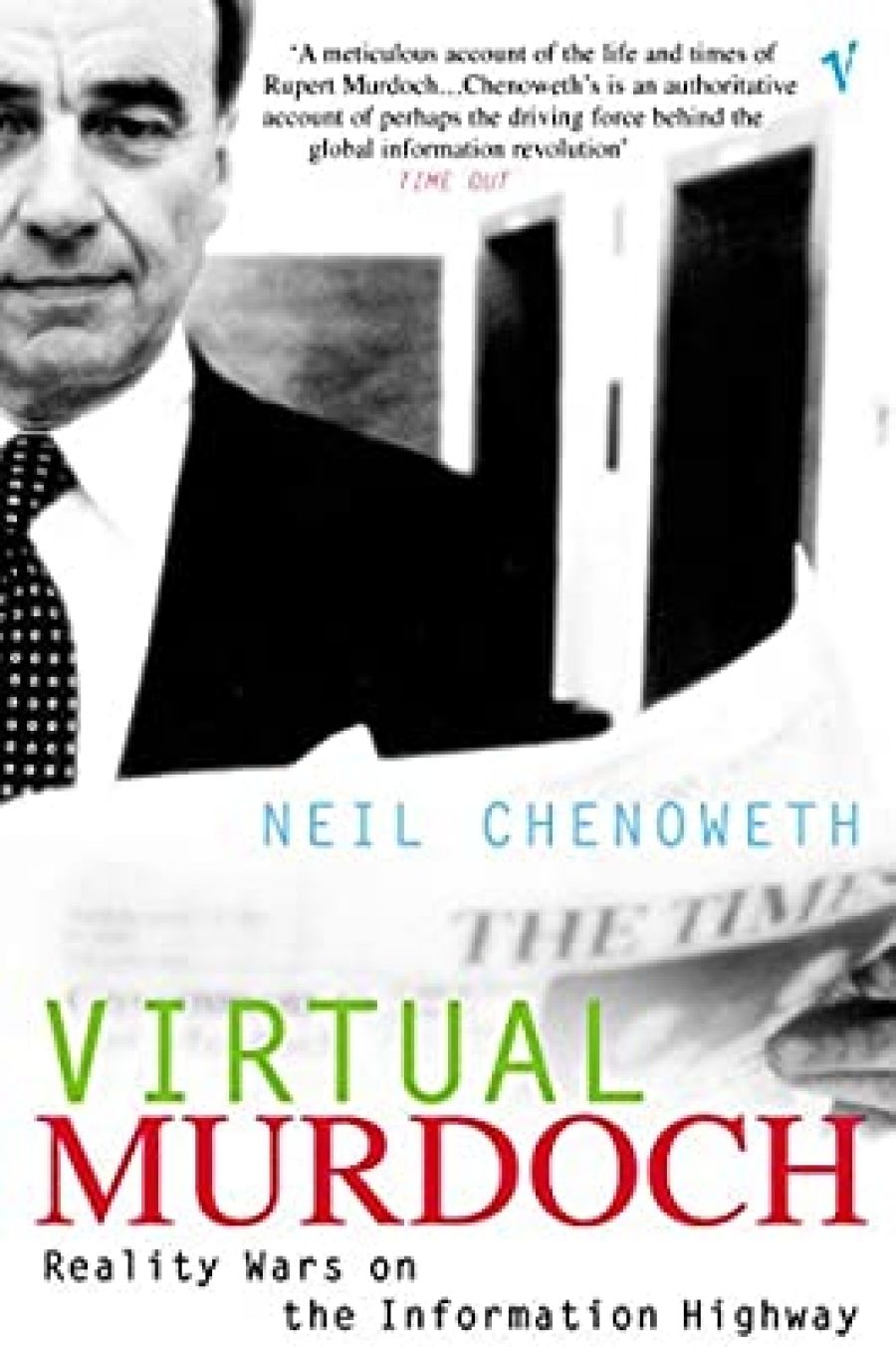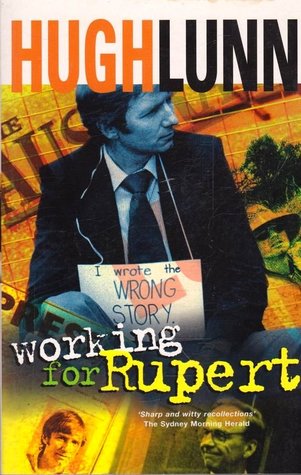
- Free Article: No
- Review Article: Yes
- Online Only: No
- Custom Highlight Text:
In the last week of June, after a period in the doldrums, the News Corporation share price suddenly took wing again. Buyers piled in. A lazy few hundred million dollars were added to the company’s value. The basis of the revaluation? Apparently, Rupert Murdoch himself had descended from Olympus to participate in a presentation to sharebrokers in Sydney. Enraptured at this visitation, analysts had upped their profit projections for News.
- Book 1 Title: Virtual Murdoch
- Book 1 Biblio: Secker & Warburg, $50 hb, 399 pp
- Book 1 Readings Link: booktopia.kh4ffx.net/jKYLe
- Book 2 Title: Working for Rupert
- Book 2 Biblio: Hodder & Stoughton, $29.95 pb, 245 pp
- Book 2 Cover Small (400 x 600):

- Book 2 Cover (800 x 1200):

- Book 2 Cover Path (no longer required): images/1_SocialMedia/2021/Jan_2021/META/6857022._SY475_.jpg
Neil Chenoweth inclines to a similar view in his Virtual Murdoch. His subject is ‘a master of appearance, a conjurer of realities’, a postmodern creation, elusive and slippery. The book, consequently, is ‘not a conventional biography’, but an attempt to chronicle Murdoch’s compulsive wheeler-dealing on four continents throughout the 1980s and 1990s. Even so, the book has to be selective in what it includes and excludes. Murdoch is the businessman as shark; only his motion keeps him alive.
Chenoweth is a first-rate financial journalist, one for whose Australian Financial Review byline I have always kept a lookout. He is thorough and tenacious, adept at identifying the form and substance of transactions, and contextualising them in terms of shifting markets. Murdoch denied his requests for access, of course, but Chenoweth sniffs round deals like a dog worrying a bone. His reportage of the bid by Murdoch’s family company Cruden Investments for Queensland Press is a splendid example of financial forensics, while his description of the apparent affection within News Corporation for symmetrical financial results is downright funny. Such is the aptitude within the company for financial engineering that between 1987 and 1992 the company produced a succession of results in which the numbers after the decimal point mirrored those before it: $391.391 million, and so forth. ‘A unique accounting culture’, Chenoweth wryly observes.
When the story moves beyond the deal, Chenoweth is less sure of himself. The book begins with a detour to Murdoch’s origins, his upbringing and education. Suddenly, we are considering the influences on Murdoch the man – his driven father and dutiful mother, his experiences at school and university – and it’s frankly unconvincing. There is one particularly ambitious supposition: that Murdoch was coloured ever after by his exposure at Oxford to game theory, with its ‘implicit suggestion that the successful player in business or politics was the one ... who cut corners, who broke unwritten rules’. Murdoch, it seems, knew a mathematician who specialised in it. Yet it is a clumsy conjecture, as there appears to be no evidence of Murdoch mentioning either the mathematician or game theory in later life, and also a tad showy (especially given that von Neumann and Morganstern’s Theory of Games and Economic Behaviour has been misdated by fifty-five years). It reminded me of a story in Tom Bower’s recent biography of Richard Branson that as a boy the British mogul manqué always cheated at Monopoly, as though from this a lifetime’s misdeeds could be extrapolated. This chapter of Chenoweth’s book also sits uneasily with the remainder, where Murdoch emerges as anything but the captive of his past.
The other disappointment of Chenoweth’s book is the prose. It is grounded pretty solidly in cliché – time bombs tick, ghosts are laid to rest – and sometimes compound cliché: ‘Murdoch’s future now hung on a knife’s edge. For months he had kept any number of balls up in the air.’ There are infelicities such as ‘the pressures on his family had seen his daughter Elisabeth leave her job at BSkyB’ and ‘that chemistry would be the underlying driver’ (of the relationship between Murdoch and Ted Turner). There are also some outright eccentricities. Murdoch maintains ‘a frenetic sort of schedule that would put most people on Prozac’, shares ‘acquire the social appeal of the meningococcal virus’, while one deal is described in a way I simply do not understand: ‘It was a fairytale story line as old as the world: Heidi meets Godzilla, Beauty sells out to the Beast, King Kong runs away with Jessica Lange.’ Finally, a fair sprinkling of typographic errors have slipped past the proofreader, albeit one I rather like: ‘In gold there was also a failed attempt backed by Greg Norman to finance a rival to the PGA tour.’ I take it Chenoweth means ‘golf’ rather than ‘gold’, though the misprint may have revealed a subtler truth.
I can forgive this book quite a lot. Journalists who undertake serious non-fiction these days ford a widening income gap: newspaper salaries have skyrocketed over the last five years – ridiculously so, in my opinion – while book advances have remained paltry. I do feel as though I understand Murdoch’s modus operandi better after reading Chenoweth’s book, though not perhaps Murdoch himself. He is less rather than more intelligible when the book ends, inexplicable perhaps even to himself.
Murdoch is likewise an insubstantial presence in Hugh Lunn’s memoir of his years in and out of The Australian. He worked ‘for’ Rupert rather than ‘with’ Rupert, and his experiences of his boss were neither extensive nor particularly memorable, though Lunn does reveal a keen eye and a light touch. On one fleeting encounter, he notices how wizened his proprietor has become: ‘It seemed to me that the more success he had, the less he self-indulged; the more powerful he got, the less he needed to reward himself.’ He also sups with the heir apparent, Lachlan, who ‘observed each person at the dinner as if assessing the coloured balls on a snooker table’. Elsewhere, however, the book is a fairly run-of-the-mill series of journalistic reminiscences, some diverting, some predictable, some rather self-regarding.
Lunn admits that, in the early stages of his feature-writing career, colleagues parodied his predilection for the personal pronoun. He remains somewhat defensive about it. Indeed, living in a newspaper age when column after column teems with the oh-so-fascinating minutiae of its contributor’s life, it is strange to reflect that the use of ‘I’ was once considered a journalistic taboo. All the same, there is a little kernel of revenge at the heart of Working for Rupert. Lunn is going to do it his way this time, telling you not only about all the stories he wrote, but those that ‘they’ wouldn’t let him write— ‘they’ being that eternal scapegoat of the toiling hack, ‘management’.
Every journalist fights with management: the tensions are as inevitable as those between staff and line in the military. The rigidity of the 24hour cycle maximises the potential for petty animosities based on mistakes, misunderstandings and flashes of anger and petulance. This was, in my experience, especially so at The Australian, which labours under the misapprehension that it is a national newspaper rather than a Sydney newspaper with a number of bureaux united solely in their detestation of head office. And with this in mind, I found it difficult to buy into Lunn’s version of his gradual alienation, which is that he broke ‘all those corporate rules: never complain, never explain, never resign, never pick your nose in the car park’. In airing complaints such as the one that The Australian didn’t cover the launch of a book he had written, Lunn succeeds only in sounding a bit precious.
There is ample scope for more writing about Murdoch, if only for the reason that, as Nicholas Coleridge comments in his Paper Tigers, his machinations have produced ‘a freemasonry of malcontents with a story to tell’. But it is getting harder. At least when George Munster wrote the first Murdoch biography, A Paper Prince (to my mind still the best), his subject was verifiably somewhere. Now that he is apparently everywhere and nowhere, the task might best suit a metaphysician.


Comments powered by CComment